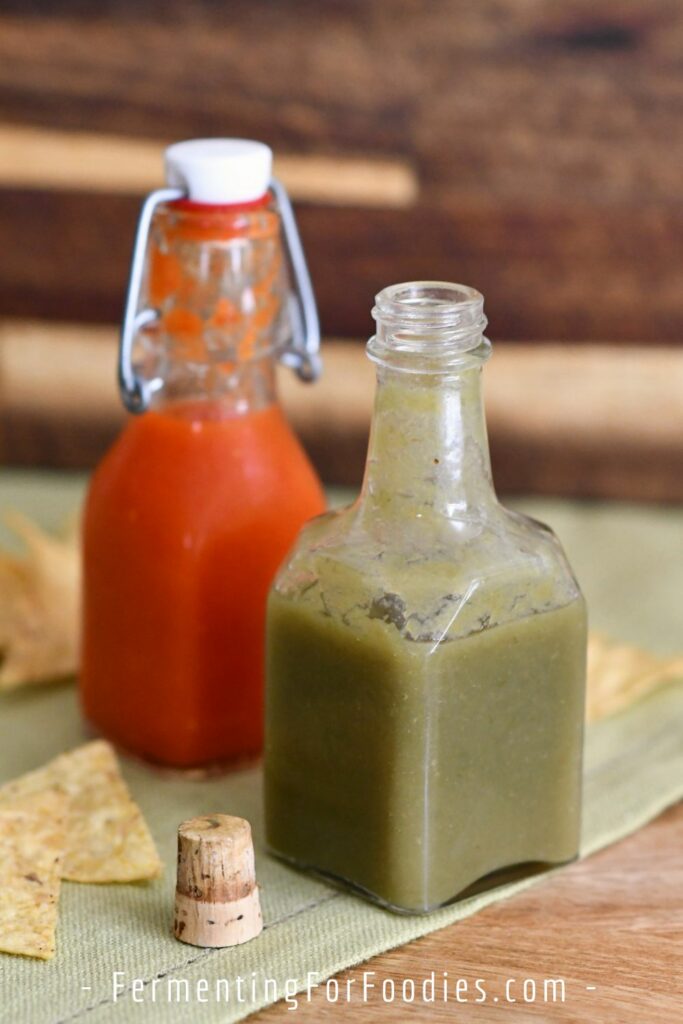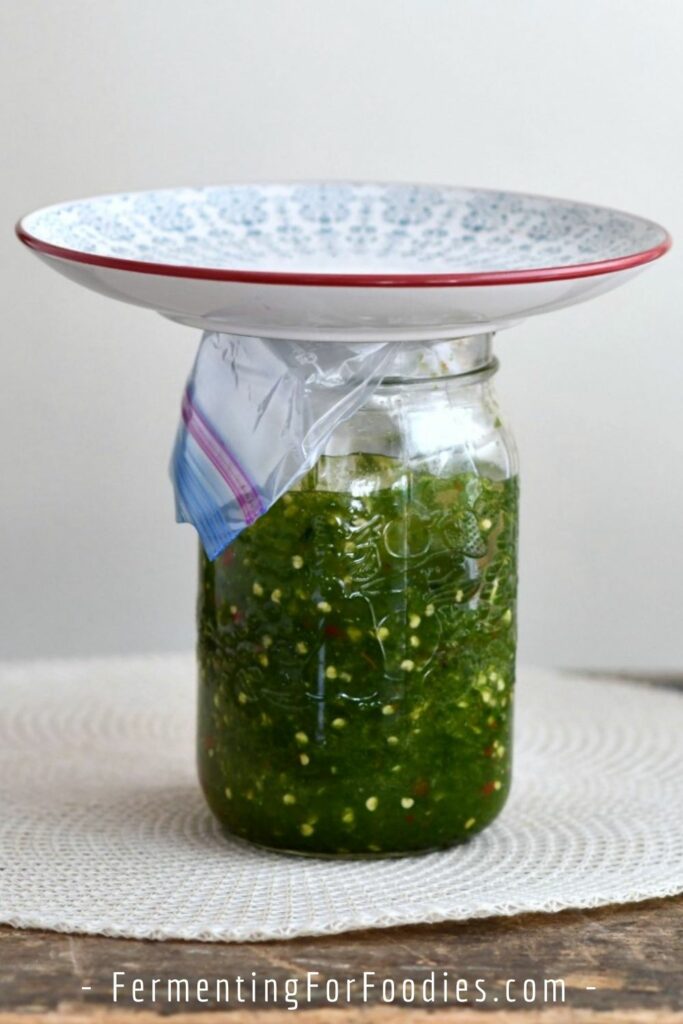Hot sauce is one condiment that seems to have a cult following. There are so many different styles, flavors, and heat levels. But the key to a really amazing hot sauce is FERMENTATION!

Here is everything you need to know to create your own unique fermented hot sauce. Whether you like it mild or hot, it’s so EASY to make a full-flavored and delicious hot sauce.
Types of Hot Peppers

To make your own brand of fermented hot sauce, you need to figure out how hot you want it. The key is in the combinations of peppers you use. There are literally more than 50,000 different types of peppers worldwide. Here are a few of the more commonly found types of peppers and their hotness on a scale of 1 to 5:
- Sweet bell pepper: This mild, snacking pepper is not at all hot. I often include some sweet peppers in my hot sauce. (See red sauce in photo above).
- Poblano (Ancho): A large dark green pepper that is a fairly mild 2.
- Hot Banana: There are also sweet banana peppers, but the hot ones are a bit spicier at a rating of 2.
- Jalapeno (or chipotle when dried and smoked): An easy-to-find hot pepper with a spiciness of 3.
- Cayenne and Thai Chili: Both are small, thin red peppers that are a 5 on the scale of spiciness.
- Habanero: A small bright orange pepper that is another hot and spicy 5.

Hot Sauce Flavor Combinations
There are so many options for flavoring homemade hot sauce.
–> Add onions, carrots, sweet peppers, or fruit. (Hot peppers are hot. I usually only use 4 to 6 chili peppers with other fruits and vegetables).
—> Add vinegar or lemon juice after fermenting for added acidity. (This fermented hot sauce doesn’t need the extra acidity; however, if you like a more acidic hot sauce add 1 Tbsp of vinegar after fermentation).
Here are a few of favorite hot sauce combinations.
- Mild Manners Hot Sauce: This is a kid-friendly, “not-hot” sauce. Use 3 1/4 cups of sweet pepper, 1/4 cup of onion, and 2 or 3 hot banana peppers.
- Sweet Mango Hot Sauce: Use 3 1/2 cups of mango and 6 to 12 cayenne peppers. Then add 1 Tbsp of lime juice and 1 tsp of sugar after fermentation.
- Smokey Chipotle Sauce: I love the flavor of chipotle peppers. Use the whole dried pepper, not the jarred ones. Grind 8 chipotle peppers up with 1 cup of onion and 2 1/2 cups of sweet peppers. Add an extra 1/4 cup of water to the batch to re-hydrate the chipotles.
- Knock Your Socks Off Sauce: Use a mix of straight jalapeno and cayenne peppers for the hottest of hot sauces. (I’ve never tried this… but you if you could! Be careful, including the seeds in your hot sauce makes it pretty hot. I find that 12 cayenne peppers generally makes a hot sauce on par with most commercial varieties.)
- Red Hot Sauce: The sauce in the photo above was made with 3 1/2 cups of red pepper and 4 Thai chili peppers.
- Peachy green Sauce: The green sauce in the photo above was made with 3 1/2 cups of peaches and 8 jalapeno peppers. (It’s my teen’s heat level).
Tried any other combinations? Share your favorite flavors in the comments section!
For anyone new to fermenting, here’s a video showing each of the steps in the recipe.
Fermented Hot Sauce
This simple fermented hot sauce recipe is designed to help you create your own signature hot sauce flavor. Add fruit, vegetables, or spices. Make it as hot or not as you want!
- Prep Time: 15 minutes
- Total Time: 15 minutes
- Yield: 1/4 to 1/2 cup 1x
- Category: Condiment
- Method: Fermented
- Cuisine: Mexican
- Diet: Vegan
Ingredients
- 3 1/2 cups of coarsely chopped vegetables and/or fruit
- 4 to 12 hot peppers, with the seeds left in (see section above for the different heat levels)
- 3 cloves of garlic
- 1 Tbsp salt (non-iodized)
- 2 Tbsp of water, as needed, to cover (chlorine-free)
Instructions
- Usually, hot sauce is made with a combination of sweet and hot peppers. However, it’s OK to use whatever flavors you want. If you’re new to DIY hot sauce, it is tempting to use just hot peppers, but it will be hotter than you expect. See the section above for a few of my favorite combinations.
- Finely chop all the vegetables in a food processor or blender. Add the salt and continue to pulse until it’s as smooth as possible.
- Scrape the hot sauce puree into a quart-sized (1L) jar for fermenting. Depending on the combination of vegetables, you may need to add a bit of water to keep everything under the liquid. To keep everything below the liquid for fermenting, use a zip-top bag filled with water as a weight. Generally, I don’t recommend using plastic bags for fermenting, but in this case, it’s the best option.
- Store the jar in a dark location for fermenting and let it ferment for 5-7 days.
- When you have finished fermenting, strain the pulp through a fine-mesh sieve, squeezing out all the liquid. Store the hot sauce in a jar for serving and discard the pulp (or see notes for a suggestion on how to reuse the pulp).
- If you want to add additional flavors like lime juice, vinegar, or sugar, add them at this point.
- Store your hot sauce in the fridge and use it within 1 month (for hot sauce). You can also freeze hot sauce to increase the storage time. I usually store my hot sauce in 1-cup jars. That way I can freeze it in small batches.
Notes
- The combination of hot peppers and salt will help prevent your hot sauce from going off. However, hot sauce is prone to kahm yeast. Kahm yeast isn’t an issue, just make sure it’s not mold.
- Don’t throw out leftover hot sauce pulp! It’s packed full of flavor, perfect for adding to chili or tortilla soup.
Nutrition
- Serving Size: 1 Tbsp
- Calories: 2
- Sugar: 0.3g
- Sodium: 97mg
- Fat: 0g
- Saturated Fat: 0g
- Carbohydrates: 0.5g
- Fiber: 0.1g
- Protein: 0.1g
- Cholesterol: 0g



Would like to know how to fermented what is the procedure thank you
Hi, I pretty much ferment exactly as I describe it in the recipe. Just pack the vegetables into a jar, and keep them below a salt brine. They will naturally ferment within 2 weeks. Good luck!
If I want to add fruit do I add it with the peppers to ferment or do I add it after?
Add everything you want to ferment in with the peppers. Enjoy!
Currently working on a recipe and I have finally made my first brine on the 17th of Nov. and unfortunately, kham yeast was able to grow maybe because of our tropical temp. I will push through with the fermentation and planning to blend them up after a month. Is it a good idea to add fresh chillis upon blending? Will it intensify the flavor and increase the heat?
That’s a great idea! Since fermenting does mellow out the heat, adding fresh chillis should make it hotter.
Hello,
I’ve two fermentations going both with a mix of chillies, onions, garlic and mango, after about a week and a half everything started to squeeze down, (perhaps a little hot, (27degC) the weight I use might be too heavy or didn’t pack the jars tight enough, Ive moved them to a cooler area. could I add more ingredients, ie belle peppers etc to take up the new space and continue the ferment I’m aiming for 6 or so weeks or longer.
Cheers
Jhnshep
Thanks for sharing! Sounds delicious!
Hi Emillie. I’m wondering why you strain out the chili pulp? I’ve just been looking at some recipes for homemade sambal oelek and they didn’t strain the pulp (but it wasn’t fermented, so perhaps that’s a reason for straining vs. not straining?).
Hi Jessica, Sambal oelek is traditionally pulpy with chili seeds left in it. Most hot sauces are smooth. It is just a matter of personal preferences. I do recommend keeping the pulp as an addition to soups and sauces… though beware, it will be very hot! Cheers, Emillie